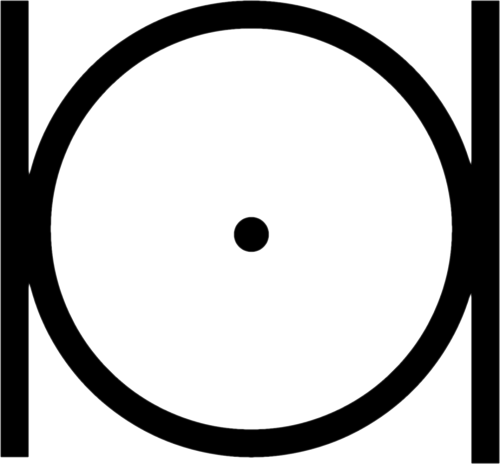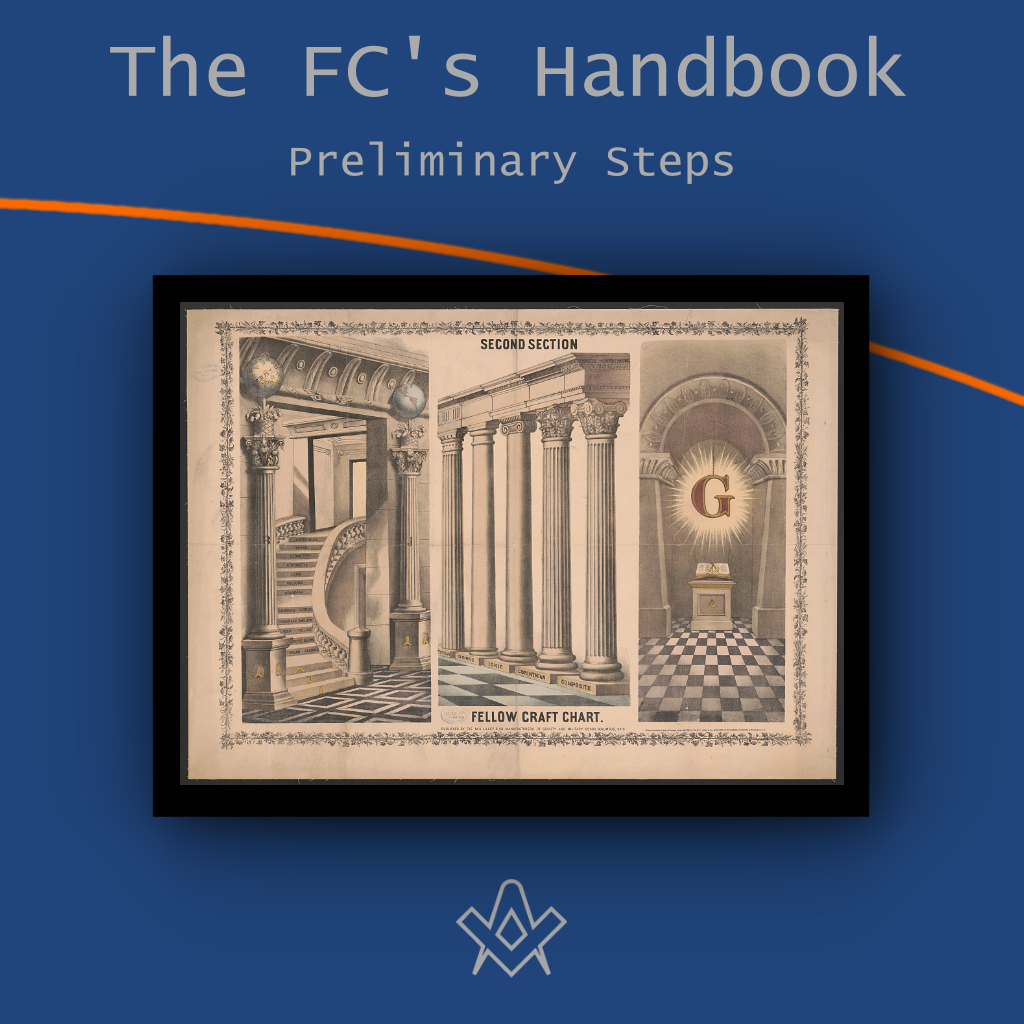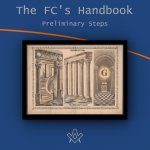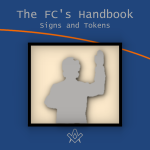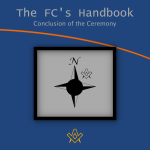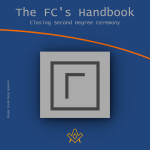The Tiler gives the knocks. of an Enter Apprentice for the candidate, thereby emphasising the fact that it is an Enter Apprentice, a stranger to a Fellowcraft Lodge, who seeks admission.
CHAPTER II – Preliminary Steps
The Inner Guard should therefore say, ” There is an alarm,” as is done in most old provincial workings, instead of “a report,” a word suitable for announcing that there is a Fellowcraft. outside. Symbolically the difference between the knocks of an Enter Apprentice and an Fellowcraft is most significant.
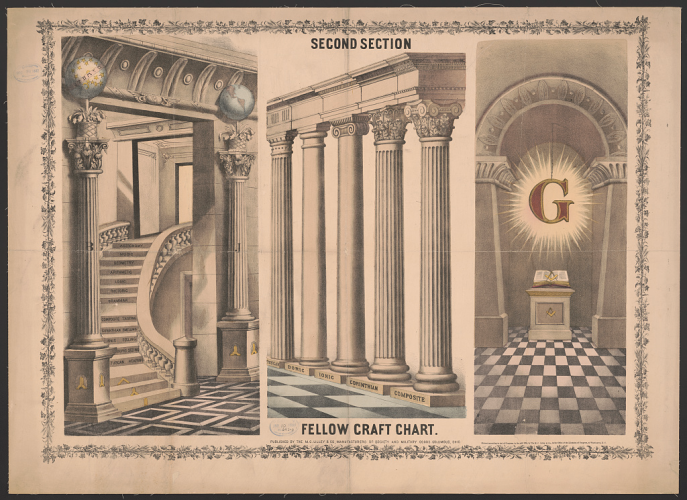
Fellow Craft Chart, 1883.
IMAGE LINKED: Library of Congress Attribution 4.0 International (CC BY 4.0)
The three separate knocks indicate that the body, soul and spirit are all equal and at variance, whereas the one and twopence show that the two lower, namely, soul and body, are now united.
This means that the soul of the Fellowcraft dominates the body, and in view of the fact that spiritual progress while on earth is dependent on this, the arrangement of the knocks is most important.
The candidate, having been properly announced, is admitted on the square, implying that he has been proved to be a man of rectitude and has therefore learnt thoroughly the lesson of the first degree, which is good morals.
Throughout the whole of this degree stress is laid on the fact that only a man of good moral standing can be permitted to extend his researches into the intellectual spheres.
Philosophia et septem artes liberales, the seven liberal arts. By Herrad of Landsberg – Hortus deliciarum, Public Domain
IMAGE LINKED: wikimedia Attribution 4.0 International (CC BY 4.0)
The other important point which is early impressed on the candidate is the fact that God is called by a new title. He is no longer spoken of as the Great Architect., but as the Grand Geometrician.
We shall revert to this point later, but even at this early stage it is desirable to point out that the aspect of God emphasised in the first degree was the creative aspect (Brahmna of the Hindus), this is most appropriate for a degree dealing with birth, both physical and spiritual.
The second degree deals with the preservative side of God; it is essentially the degree of life, which is educational for the soul. After invoking a blessing the candidate is led round the Lodge with the sun and tested.
Note, it is the body, or Junior Warden, which now does the testing, but when candidate is led round the second time, to show that he is properly prepared and in possession of the password which will make him in tune with the rest of those present, it is the Senior Warden, or Soul, which tests him.
Moreover, the Soul first satisfies itself that the Body has done in work properly, therefore the candidate advances with step and sign, before giving the password.
Having satisfied himself on this point, the Senior Warden calls on the Divine Spirit, represented by the W.M., for help, but as in the former degree, is told that it is the Soul that must instruct the candidate to advance towards God.
The Soul therefore tells the Senior Deacon, representing intelligence, to instruct the candidate how to advance.
This method of advancing is exceedingly interesting, and worthy of detailed consideration.
The five steps undoubtedly have reference to the five senses, which represent the physical man, whilst their spiral nature recalls the point within a candidate hinted at in the tracing board of the first degree, and reminds us that round it the brethren cannot err.
This clearly teaches us that we advance spiritually from within, by bringing under control all five senses and directing them towards that Middle Chamber where dwells the Divine Spark, or God.
As this subject will be treated at greater length when we come to the tracing board, we will merely point out that this manner of approach brings the candidate to the V.S.L., which is God’s revealed word.
It should also be compared with the manner of approach in the first degree, which in the last book we saw disclosed the fact that the God we sought was within us, while His triple nature, and likewise that of man, is subtly suggested.
Here we are taught the same idea, but from a slightly different angle, and are reminded that we are approaching Him by means of our five Physical faculties.
But as we arrive at the safe place, we perceive He is the same God, although during our obligation we learn of another aspect of His nature.
One other fact is worthy of our attention. Whereas in the first degree the candidate was instructed to advance towards the pedestal, in this he is told to advance to the east.
What is the reason for this difference? It will be remembered that in the first degree he is hoodwinked and therefore unable to tell which is east and which west by the time he reaches the second degree not only can he see, but his previous experience tells him exactly where it is he will take his obligation.
Esoterically, in the first degree he had no clear idea where to go for light, he was merely groping blindly, although led by a friendly hand: but in the second degree, having learnt that the true light comes from the east, there is no reason why this phrase should not be employed.
The position in which he takes his obligation again makes the three squares, but the instrument which he has to hold, and the manner in which he holds it, produce two more, making five in all- corresponding to the five senses, this irrespective of the sixth on the alter or pedestal.
To begin with, these five squares indicate that all our senses must be dedicated to and ruled by, the strictest moral conduct e.g., “Speak no evil, see no evil” etc, but when we recollect that in the first degree we got by means of the squares a suggestion of the Divine Name, we shall not be surprised to find that here again the Divine Name is indicated, but with two profound differences.
Firstly, the Name is complete within ourselves, that is, without needing to utilise the square and secondly, it is no longer the four lettered Name of the Creator, Yod-He-Vau-He, but the five lettered Name of the Preserver, Yod-He-Shin-Vau-He, or Yeheshuhe, which we call Jesue or Jesus.
As we learn from the Kabala, the Shin has descended to earth and by combining with the other four letters has made the Divine Name masculine instead of feminine, for Shin is masculine.
Secondly, it is the name of the Messiah. Now it has already been pointed out that the manner in which the candidate kneels and also his preparation, emphasise the masculine aspect of this degree.
Likewise, the Name by which God is spoken of emphasises His Preservative character, in contra-distinction to the first degree where He is spoken of in His Creative aspect and the feminine side is stressed.
Finally, the fact that the whole Name is made by the man himself must be considered in conjunction with what has been said about the manner of advancing by the winding staircase, and the Middle Chamber.
The Kabala teaches us that Messias is made flesh, and this implies more than the fact that on a certain historic occasion God became manifest in a human body.
It indicates rather that God is always being made manifest in every human being, and so the candidate, though he knows it not, is a manifestation of God on earth.
Thus in a sense he himself represents the missing letter Shin, and so, when our ancient brethren entered the Middle Chamber to receive their wages and saw the Mystic name Yod-He-Vau-He, they themselves represented that fifth letter, which turned the name of the Creator into the name of the Preserver and Saviour of mankind.
Perhaps I should point out this is not strictly orthodox Christianity, but Kabalism, although its similarity to much that is taught to us as Christians is dear.
Before leaving this subject I should like to remind any Master Mason who read this book of the manner in which they approach the pedestal in the next degree, for if correlated with what has gone before, the full significance of that manner of approach will be evident to them.
The square on the pedestal indicates that there is still another aspect of God about which as yet the candidate, learns nothing, and its combination with the compasses to make a lozenge should remind him that, though this degree is essentially, masculine, God the Preserver has also His feminine aspect.
The variation in the position of one of the points is explained at the time, but there is also a deeper meaning. One symbolical meaning of the square is the material world, and therefore the body of man.
In the first degree the body is dominant and over-shadows the spiritual side of the Candidate’s nature.
In this degree the body is dominated by the soul, but as yet the spirit has not gained control over the latter.
The compasses, representing the higher or more spiritual side of man, reveal this fact by disclosing one point only.
The obligation explains itself, and the penalty will be dealt with in the next chapter, as it can be more appropriately considered in conjunction with the signs.
As in the former degree, the candidate is raised with the proper grip which is subsequently explained to him.
Article by: J. S. M. Ward
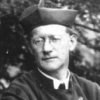
John Sebastian Marlow Ward (22 December 1885 – 1949) was an English author who published widely on the subject of Freemasonry and esotericism.
He was born in what is now Belize. In 1908 he graduated from the University of Cambridge with honours in history, following in the footsteps of his father, Herbert Ward who had also studied in history before entering the priesthood in the Anglican Church, as his father had done before him.
John Ward became a prolific and sometimes controversial writer on a wide variety of topics. He made contributions to the history of Freemasonry and other secret societies.
He was also a psychic medium or spiritualist, a prominent churchman and is still seen by some as a mystic and modern-day prophet.
Recent Articles: The Fellowcraft's Handbook
masonic knowledge
to be a better citizen of the world
share the square with two brothers

click image to open email app on mobile device
